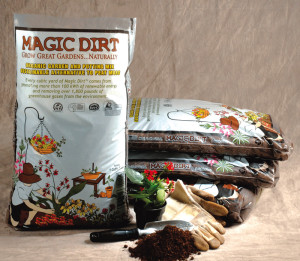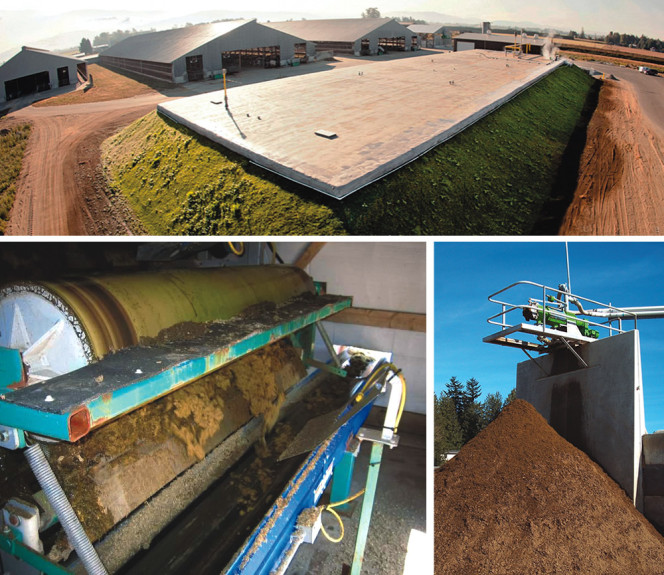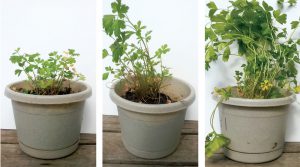An anaerobic digester development company launched a bagged potting soil product to utilize digested dairy manure fibers and improve long-term success of facilities.
Nora Goldstein
BioCycle July 2014

Magic Dirt is blended with natural recycled materials and packaged in one cubic foot bags that are currently sold in Idaho and parts of several other Western states.
Robert Joblin and Ted Sniegocki of Cenergy USA based in Little Rock, Arkansas, are not horticulturalists or agronomists. But they are anaerobic digester developers and when falling rates for renewable energy and the loss of the federal Investment Tax Credit grant hit at the same time, the financial models they had been using “fell down.” The need for additional revenue streams for AD facilities was urgent to help projects pencil out. Joblin and Sniegocki recognized the value of the fibers coming out of digesters, but had witnessed various product development initiatives go awry. “While we knew we couldn’t finance a digester project based on revenues from fiber products, it can be the difference between a successful project and one that is not,” notes Joblin. “We believed that we needed to develop a value-added bagged retail product.”
Three or four years ago, Cenergy hired consultants to help figure out markets for the digested dairy manure fibers coming out of two large-scale facilities the company had helped develop in Idaho. “They had us talking with various soil products companies, but in the end, it was all for naught and we didn’t move ahead,” says Joblin. “Then one night, Ted and I sketched out what we wanted to do on the back of a cocktail napkin, and decided to develop a product on our own. The end result is Magic Dirt™, a bagged potting soil that has been certified as 100 percent biobased by the USDA’s BioPreferred Program and approved for use in organic production by the Idaho Department of Agriculture.” The product is also certified as a premium potting soil by the Mulch and Soil Council.
Magic Dirt, introduced in the spring of 2014, is a blend of nutrient-rich digested manure and other recycled natural materials that has a pH within the 6-7 range and a guaranteed analysis of 1.15% Total N, 0.30% available phosphate and 0.35% soluble potash. According to Joblin, that is “6- to 10-times the nutrients found in other brands of premium potting soil.” It is packaged in 1 cu.ft. bags and distributed to garden centers and big box retailers in Idaho and parts of Utah, Oregon and Washington State. “Our blend is like peat moss with natural nutrients,” notes Sniegocki. “There is a big push not to use peat moss because of the significant greenhouse gas emissions — both carbon and methane — associated with its harvesting. For every acre harvested, 2,400 tons of methane are released.” In its marketing materials, Cenergy also points out that every cubic yard of Magic Dirt “is the by-product of generating more than 100 kWh of renewable energy” and offsets methane by avoiding peat harvest. (Cenergy does not factor in methane avoidance resulting from anaerobic digestion of dairy manure.)

Cenergy has found that the DVO digester technology (top) is the most effective system for removing volatile solids and yielding long, linked fibers after solids separation (left, right). The fibers give Magic Dirt the porosity and water holding capacity that emulates peat moss.
Another driving market factor is the continuing growth of gardening in the U.S. According to market research conducted by the Garden Writers Association over a 3-year period (2010-2013), of the 164 million homeowners in the U.S., nearly half gardened in the past 12 months and on average, spent $530 to $615/year on lawn and garden products. “The study also found that 25 percent of gardening homeowners are likely to pay more for ecofriendly products such as Magic Dirt,” says Joblin.
Product Characteristics
Early on in product development, Cenergy determined it needed to use dewatered fibers from DVO, Inc.’s patented Two-Stage Mixed Plug Flow™ digester systems. “From our vantage point, the DVO digester technology is the most effective and efficient system for removing volatile solids and yielding long, linked fibers after solids separation,” explains Joblin. “The long fibers hold water and give Magic Dirt the porosity that emulates peat moss.”
Melissa VanOrnum, DVO’s marketing manager, explains that retention time in its dairy digester systems is generally engineered for 22 days. “That gives bacteria time to get the energy out and achieve pathogen kill,” she says. “The plug flow aspect of our unique hybrid design yields a guaranteed retention time. And the mixing capability eliminates stratification of the solids and the liquids so that all material is fully digested.” DVO utilizes compressed biogas to mix the waste, eliminating the need for moving parts inside the digester. “This reduces O&M costs, as well as the energy required to operate the system,” adds VanOrnum. “Our patented mixing system is also much gentler on the long fibers in the waste. Preservation of the long fibers and the more complete digestion of the starches lead to higher quality solids that are more peat-like in appearance.”
The digested fibers do not have to go through a composting phase prior to bagging. In the case of the Idaho dairies, only a portion of the separated fibers are used to make Magic Dirt. The remainder is used for bedding at this time. “We are taking it one step at a time because we are learning every step of the way,” notes Sniegocki. “One fact we didn’t realize starting out is that the product needs to be registered in every state it is sold — as a soil amendment in some states and a fertilizer in others. The Idaho Department of Agriculture has been very supportive of what we are doing, and has helped us with registration in surrounding states.”
Blending of the fibers and other ingredients and the bagging of Magic Dirt are contracted out to a company near the Idaho digesters. The product has been analyzed extensively to verify the nutrient claims. And during testing, it was found to hold more than three times its weight in water, an attribute that makes it perform well as a peat alternative.
In April, Magic Dirt was approved as an “Idaho Preferred” product (sourced and manufactured in Idaho), and Cenergy was invited to participate in Idaho Preferred promotions at 25 Walmart stores in Idaho. “Our product had to be in the stores in May,” says Sniegocki. “We had to scramble to print the signage, but this was a great opportunity to introduce Magic Dirt.”
As the product has been introduced, one question being asked is why Magic Dirt isn’t the same price as a bag of composted cow manure, which sells for much less. “That is one of our biggest marketing challenges so far,” says Joblin. “People don’t understand the base ingredient, and we have to explain that this is a premium potting soil with peat-like attributes. That is one of the reasons we started out with getting the certifications — to distinguish Magic Dirt from other manure-based products available.”
Joblin and Sniegocki are interested in working with other digester facilities using the DVO technology, both to produce Magic Dirt as well as explore other product opportunities. Product development is slow in the beginning as a significant amount of fiber testing is needed, along with fine-tuning blends and identifying retail outlets. But the need for the long-term revenue stream outweighs that process.
“We are seeing more AD projects that negotiate a flat rate for their power purchase agreements with utilities,” explains Sniegocki. “That rate might be adequate for the first several years, but down the road, costs to maintain and operate the digester, engines, etc. go up, but the power rate is flat. So operators need to have other revenue sources to come in and cover those cost increases they will incur. Products like Magic Dirt may not be a huge piece of revenue, but they will generate enough revenue to equal out inflationary trends. That’s why we say added value products can make or break a digester’s success.”

In 2013, Cenergy put its product through the ultimate growth test — a 9th grade science fair project. Trials were done using Chinese parsley, planted in a leading brand of organic potting soil (left), soil from the flower bed of the student’s mother (center), and Magic Dirt (right).
While in initial product testing in 2013, Cenergy put Magic Dirt through the ultimate growth test, according to Joblin — a ninth grade science fair project. “The student did growth trials with Chinese parsley bedding plants. He used dirt from his mother’s flower bed, the leading brand of organic potting soil and Magic Dirt. Each was given equal amounts of water and sunlight. And Magic Dirt performed the best! He earned an A on the project.”
Mother Earth News, Cooking Light and American Gardener magazines are conducting their own Magic Dirt growth tests and will publish results by the end of this summer, he adds. “And Ted and I just finished our pitches to other chains, and it went well. Everyone seemed to like our sustainability story. Because of the market acceptance of Magic Dirt, we will be expanding our production to other states for 2015.”












